tire size CADILLAC SEVILLE 1994 4.G Owners Manual
[x] Cancel search | Manufacturer: CADILLAC, Model Year: 1994, Model line: SEVILLE, Model: CADILLAC SEVILLE 1994 4.GPages: 399, PDF Size: 21.33 MB
Page 8 of 399

Downloaded from www.Manualslib.com manuals search engine -
I
-
introduced the 1 I
which set the trend In automotlve
egendary tail fin
styling for nearly two decades. This
was followed
by the 1949 model with
the two door hardtop Coupe DeVille
and the modern overhead valve,
high compression
V8 engine.
Engineering innovations, con-
veniences and styling dominated the
'50s and '60s. Cruise control, auto-
matic climate control,
tilt and
telescoping steering wheels, twilight
sentine1 and four door hard tops all
debuted in these years. In 1957 the
Eldorado Brougham featured
ad-
vances such as air suspension, mem-
ory seat, automatic electric door
locks, transistor radio, a brushed stainless steel roof and
low profile
tires.
introduced
in
1953,was redesigned for 1967 as the
first front wheel drive personal lux-
ury car. The
472 cu. in. V8 engine
used in
all Cadillacs in 1968 and
1969 was enlarged to
500 cu. in. for
all 1970 Eldorados.
An Air Cushion Restraint Sys-
tem (airbag) was available for
1974,
1975 and 1976 Cadillacs.
Analog Electronic Fuel Injec-
tion was available, on 1975 Cadillacs
and
was standard on the new inter-
national size 1976 Seville. In 1978,
the Trip Computer option incor-
porated an on-board microprocessor.
Page 253 of 399
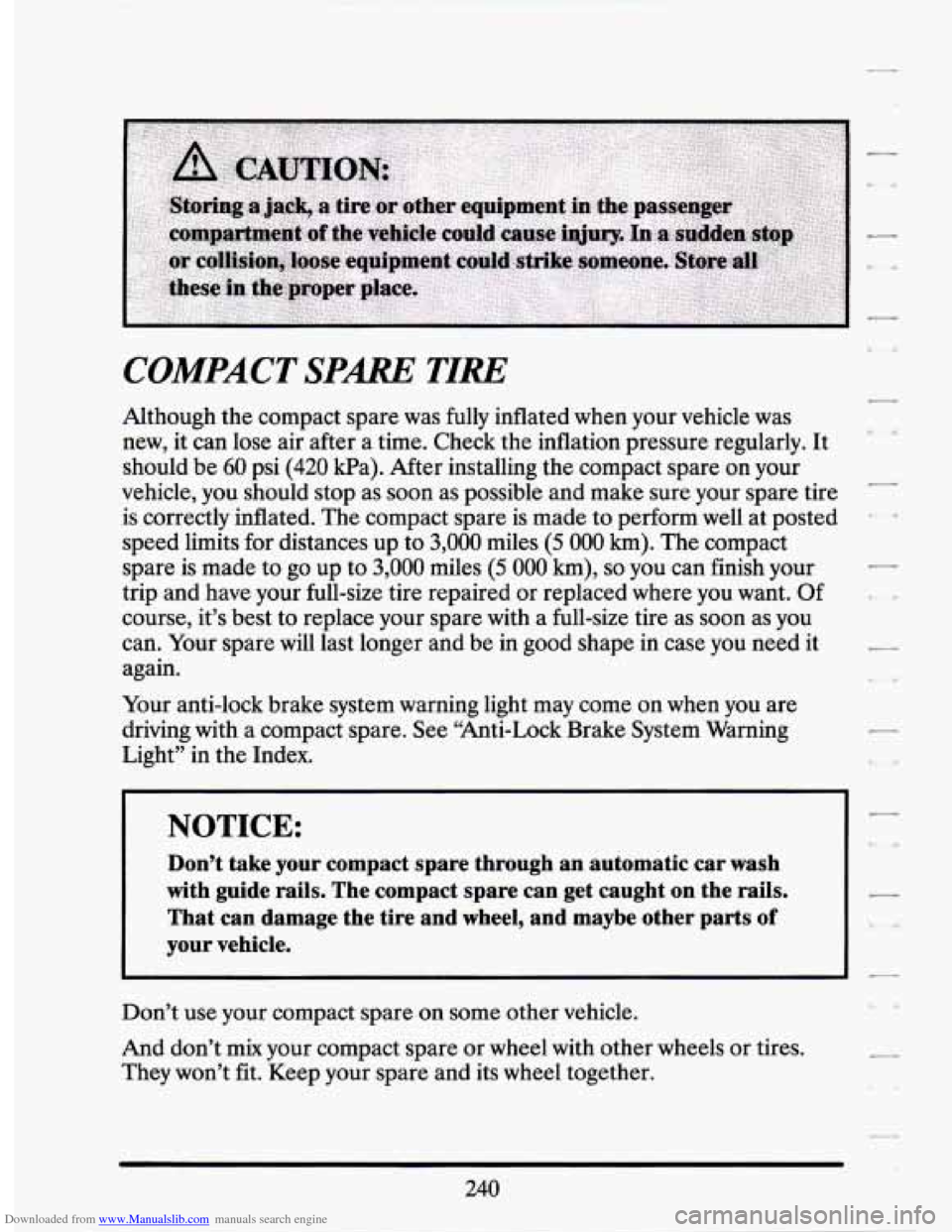
Downloaded from www.Manualslib.com manuals search engine COMPACT SPARE TIRE
Although the compact spare was fully inflated when your vehicle was
new, it can lose air after a time. Check the inflation pressure regularly. It
should be
60 psi (420 Wa). After installing the compact spare on your
vehicle, you should stop as soon as possible and make sure your spare tire
is correctly inflated. The compact spare is made to perform well at posted
speed limits for distances up to
3,000 miles (5 000 km). The compact
spare is made to go up to
3,000 miles (5 000 km), so you can finish your
trip and have your full-size tire repaired or replaced where you want. Of
course, it’s best to replace your spare with a full-size tire as soon as you
can. Your spare will last longer and be
in good shape in case you need it
again.
Your anti-lock brake system warning light may come on when you are
driving with a compact spare. See “Anti-Lock Brake System Warning
Light”
in the Index.
NOTICE:
Don’t take your compact spare through an automatic car wash \
with guide rails. The compact spare can get caught on the rails.
That can damage the tire and wheel, and maybe other parts
of
your vehicle.
Don’t use your compact spare on some other vehicle.
And don’t
mix your compact spare or wheel with other wheels or tires.
They won’t fit. Keep your spare and its wheel together.
7
240
Page 300 of 399
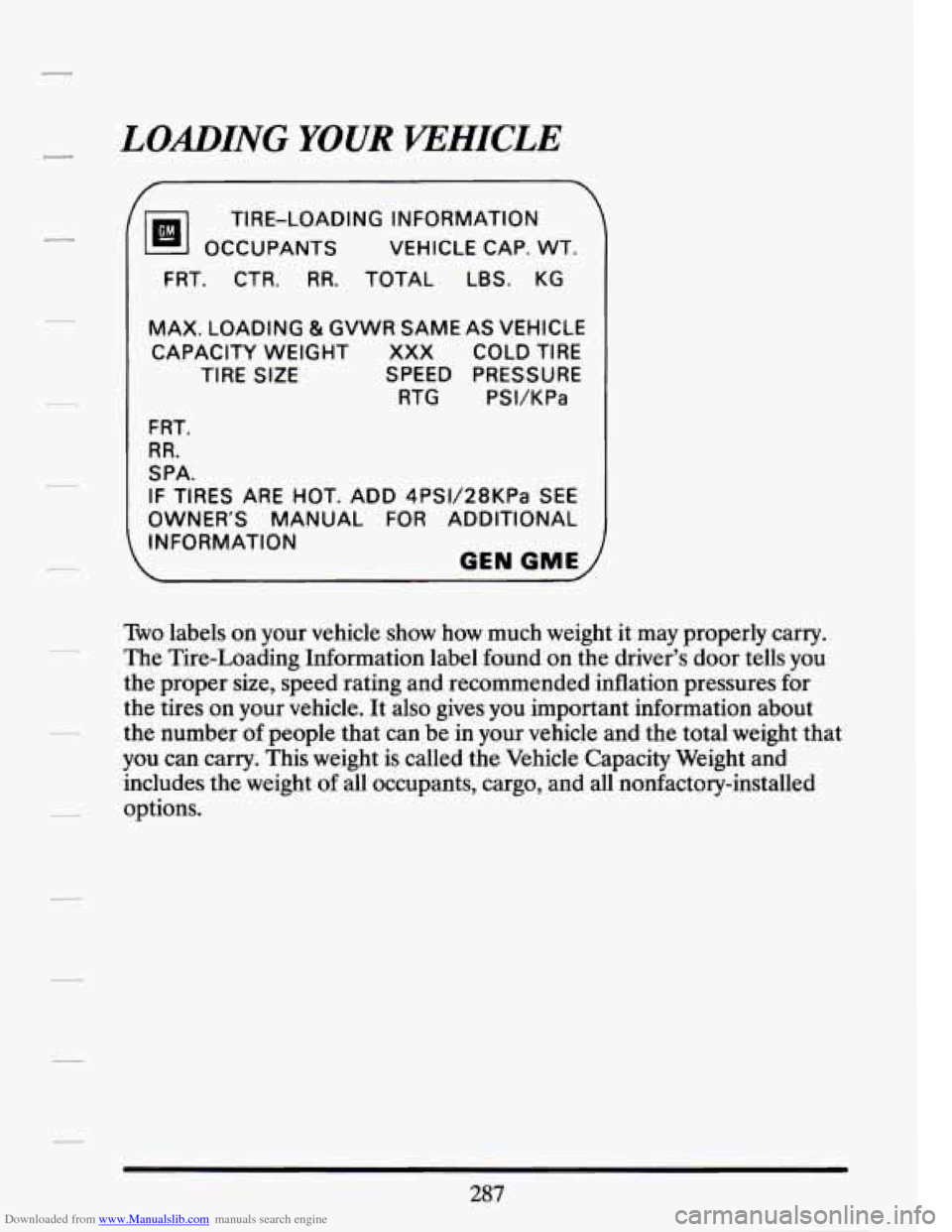
Downloaded from www.Manualslib.com manuals search engine LOADING YOUR VEHICLE
TIRE-LOADING INFORMATION
OCCUPANTS VEHICLE CAP. WT.
FRT. CTR.
RR. TOTAL LBS. KG
MAX. LOADING & GVWR SAME AS VEHICLE
CAPACITY WEIGHT XXX COLD TIRE
TIRE SIZE SPEED PRESSURE RTG PSI/KPa
F RT.
R R.
SPA.
IF TIRES ARE HOT. ADD 4PSV28KPa SEE
OWNER'S MANUAL FOR ADDITIONAL
GEN GM.E \'NFoRMAT1oN
Two labels on your vehicle show how much weight it may properly carry.
The Tire-Loading Information label found on the driver's door tells you
the proper
size, speed rating and recommended inflation pressures for
the tires on your vehicle. It also gives you important information about
the number of people that can be in your vehicle and the total weight that
you can carry. This weight is called the Vehicle Capacity Weight and
includes the weight
of all occupants, cargo, and all nonfactory-installed
options.
287
Page 304 of 399
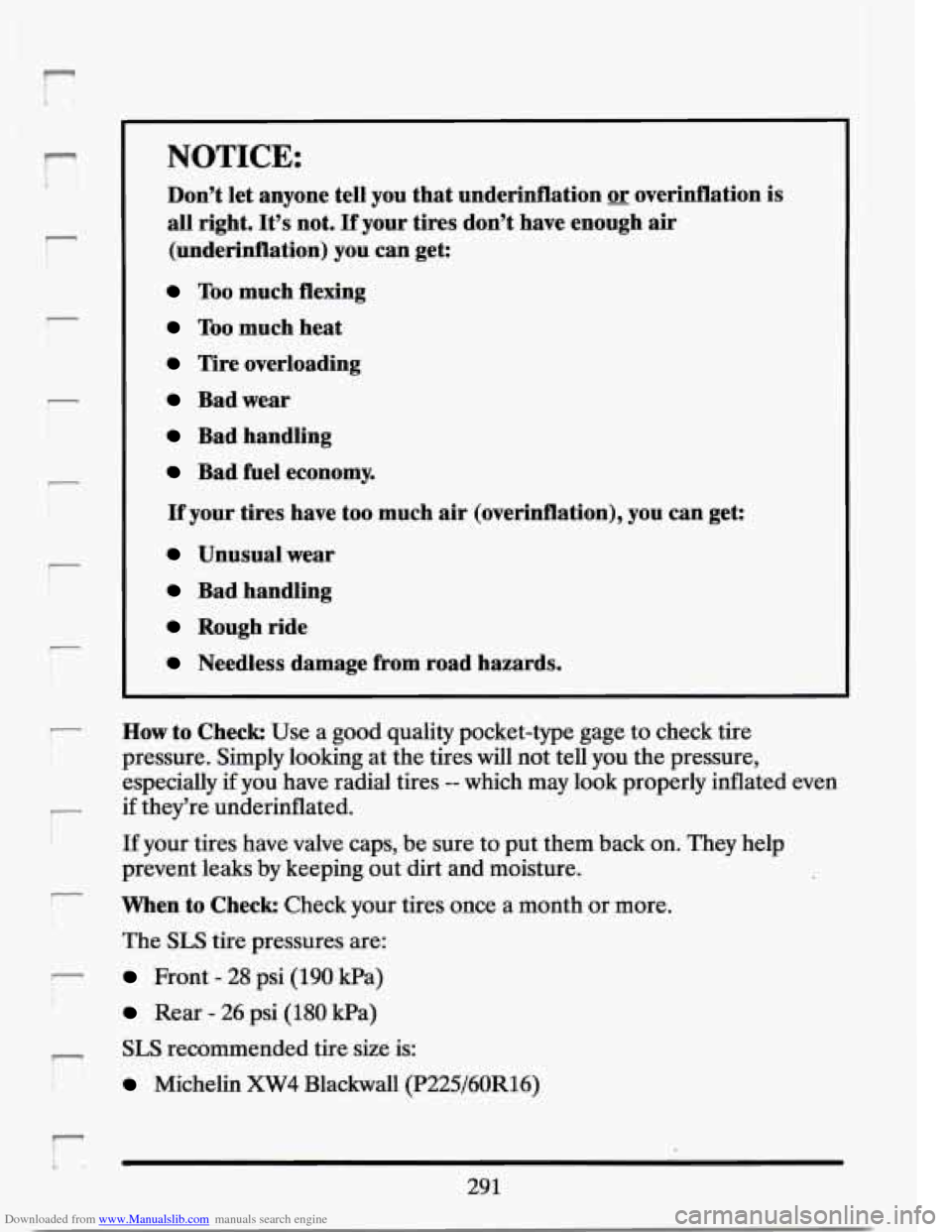
Downloaded from www.Manualslib.com manuals search engine r
f
r
r I 1
i- I
NOTICE:
Don’t let anyone tell you that underidlation or overinflation is
all right. It’s not. If your tires don’t have enough air
(underinflation) you can get:
Too much flexing
Too much heat
Tire overloading
Bad wear
Bad handling
Bad fuel economy.
If your tires have
too much air (overinflation), you can get:
Unusual wear
Bad handling
Rough ride
Needless damage from road hazards.
7 I
!
-
I
How to Check Use a good quality pocket-type gage to check tire
pressure. Simply looking at the tires will not tell you the pressure,
especially if you have radial tires
-- which may look properly inflated even
if they’re underinflated.
If your tires have valve caps, be sure to put them back on. They help
prevent leaks by keeping out dirt and moisture.
When to Check Check your tires once a month or more.
The
SLS tire pressures are:
Front - 28 psi (190 kPa)
Rear - 26 psi (180 Pa)
SLS recommended tire size is:
Michelin XW4 Blackwall (P225/60R16)
291
Page 305 of 399

Downloaded from www.Manualslib.com manuals search engine The STS tire pressures are:
Front - 29 psi (200 kPa)
Rear - 29 psi (200 kPa)
STS recommended tire size is:
Eagle GA (2-Rated) Blackwall (P225/60ZR16)
Don’t forget your compact spare tire. It should be at 60 psi
(420 kPa).
Tire Inspection and Rotation
To make your tires last longer, have them inspected and rotated at the
mileages recommended
in the Maintenance Schedule. See “Scheduled
Maintenance Services”
in the Index.
Use this rotation
pattern.
After the tires have been rotated, adjust the front and rear inflation
pressure as shown
on the Tire-Loading Information label. Make certain
that all wheel nuts are properly tightened. See “Wheel Nut Torque” in the
Index.
292
Page 306 of 399
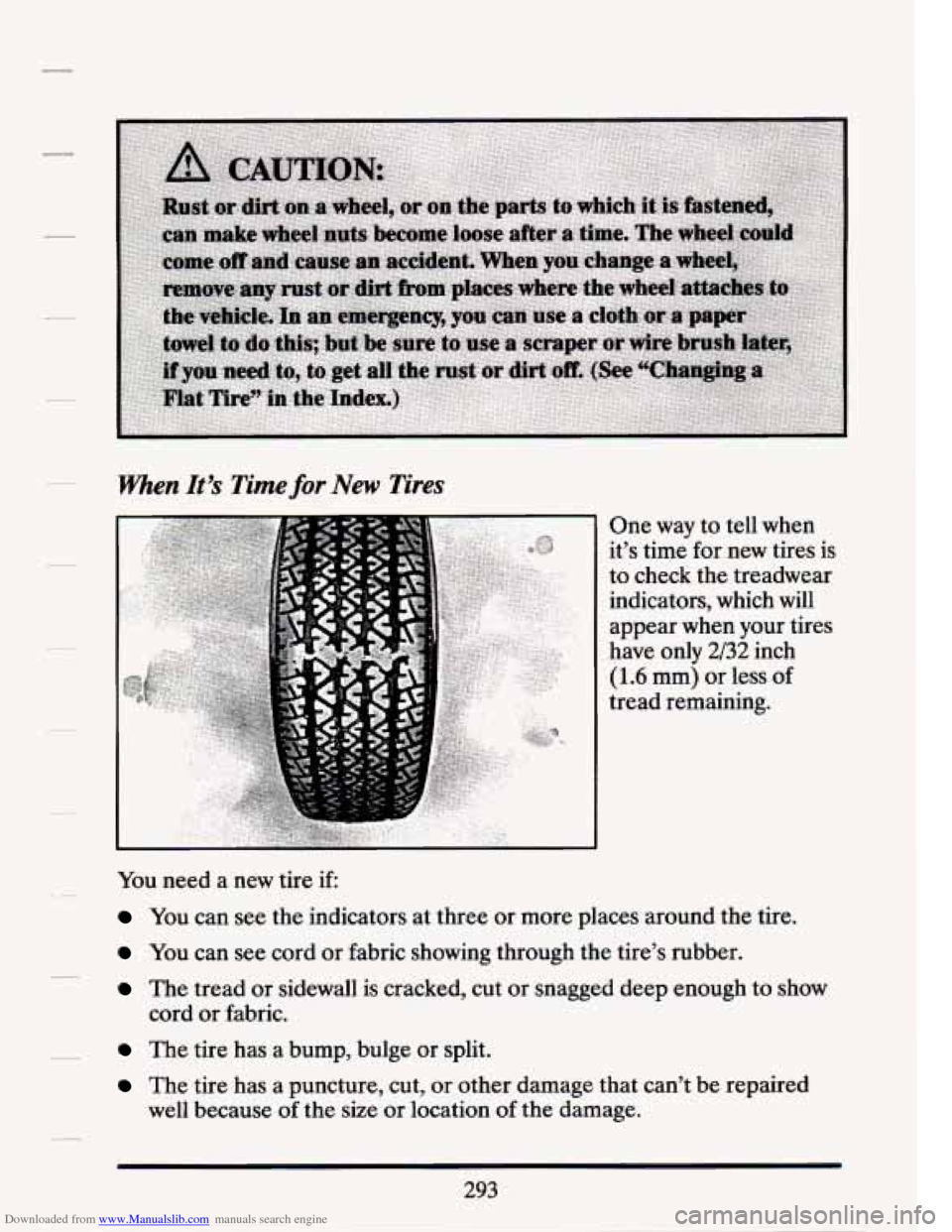
Downloaded from www.Manualslib.com manuals search engine When It’s Time for New Tires
One way to tell when
it’s time for new tires is
to check the treadwear
indicators, which
will
appear when your tires
have only
2/32 inch
(1.6 mm) or less of
tread remaining.
You need
a new tire if:
You can see the indicators at three or more places around the tire.
You can see cord or fabric showing through the tire’s rubber.
The tread or sidewall is cracked, cut or snagged deep enough to show
The tire has a bump, bulge or split.
The tire has a puncture, cut, or other damage that can’t be repaired
cord
or fabric.
well because of the size or location of the damage.
293
Page 307 of 399
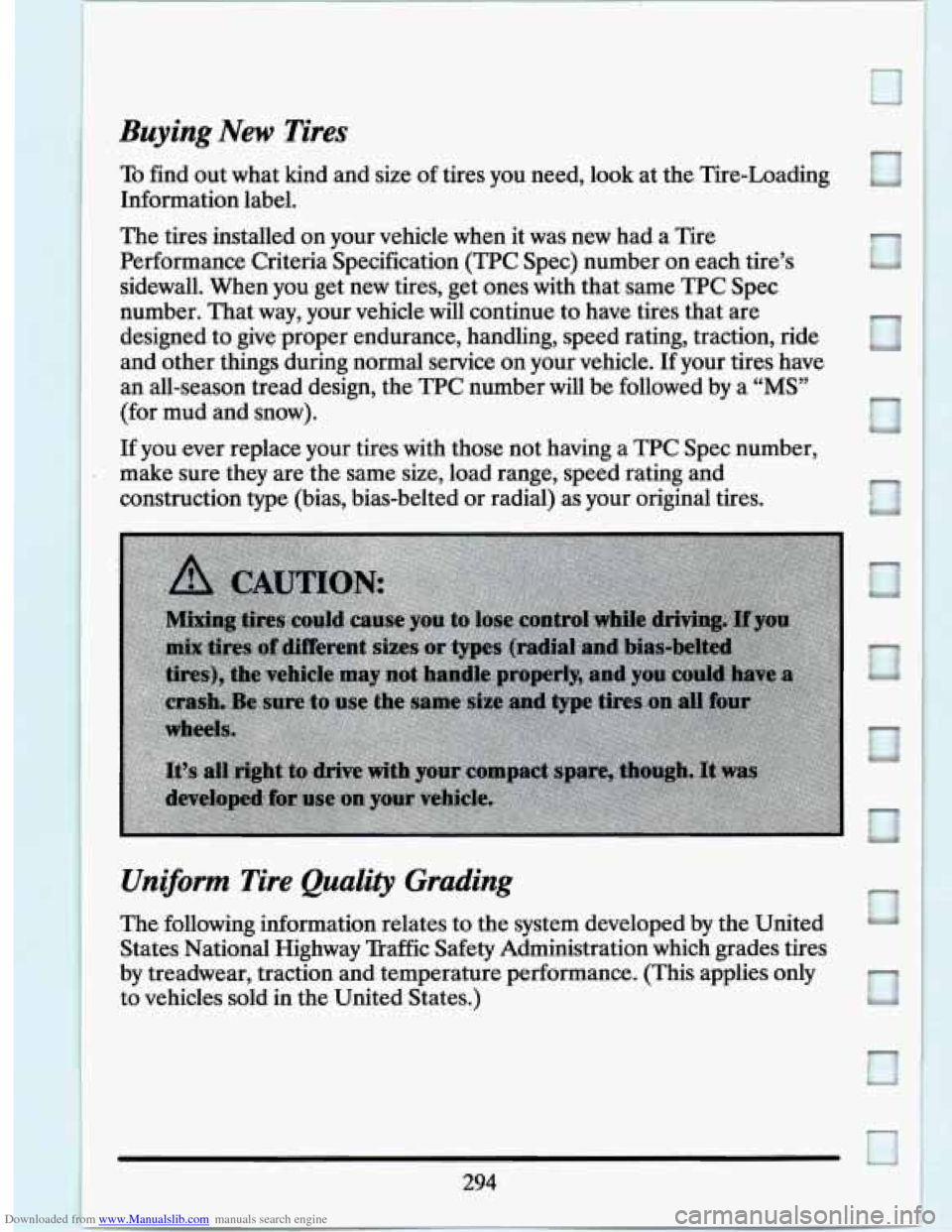
Downloaded from www.Manualslib.com manuals search engine Buying New Tires
To find out what kind and size of tires you need, look at the Tire-Loading
Information label.
The tires installed on your vehicle when it was new had a Tire
Performance Criteria Specification (TPC Spec) number on each tire's
sidewall. When yowget new tires, get ones with that, same TPC Spec
number. That way, your vehicle will continue to have tires that are
designed to give.proper endurance, handling, speed rating, traction, ride
and other things during normal service on 'your vehicle.
If your tires have
an all-season tread design, the- TPC number will be followed by a
"MS"
(for mud and snow).
If you ever replace your tires with those not having a TPC Spec number,
make sure they are the same size, load range, speed rating and
construction type (bias, bias-belted or radial) as your original tires.
Uniform Tire.Quality Grading
The following information relates to the system developed by the United
States National Highway Traffic Safety Administration which grades tires
by treadwear, traction and. temperature performance. (This applies only
to vehicles sold in the United States.)
Page 310 of 399
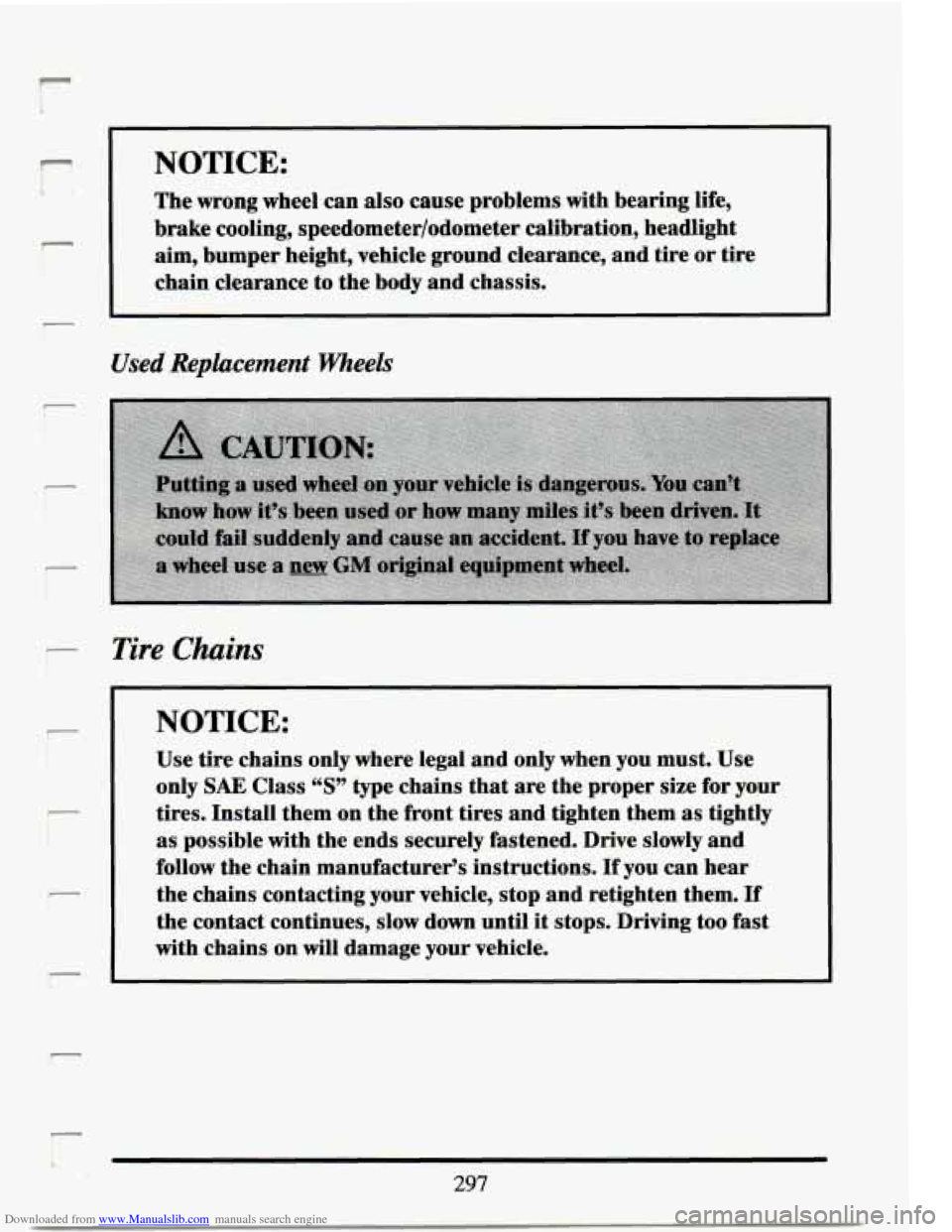
Downloaded from www.Manualslib.com manuals search engine r
NOTICE: I
The wrong wheel can also cause problems with bearing life,
brake cooling, speedometer/odometer calibration, headlight
aim, bumper height, vehicle ground clearance, and tire or tire
chain clearance to the body and chassis.
c I -
r
r-
Used Replacement Wheels
rire Chains
NOTICE:
Use tire chains only where legal and only when you must. Use
only
SAE Class “S” type chains that are the proper size for your
tires. Install them on the front tires and tighten them
as tightly
as possible with the ends securely fastened. Drive slowly and
follow the chain manufacturer‘s instructions.
If you can hear
the chains contacting your vehicle, stop and retighten them.
If
the contact continues, slow down until it stops. Driving too fast
with chains on will damage your vehicle.
297
Page 320 of 399
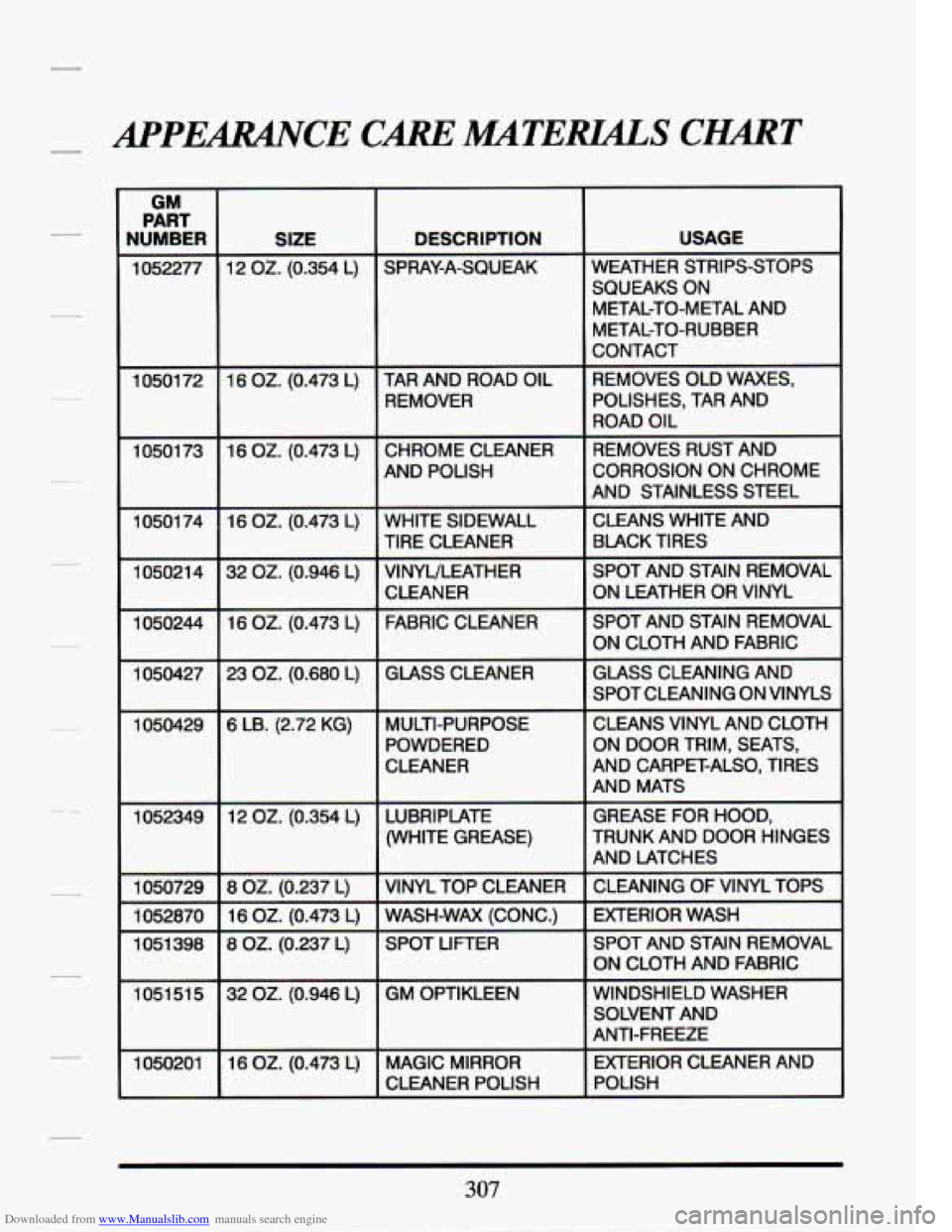
Downloaded from www.Manualslib.com manuals search engine 4PERANrE CAREMTERLALS CHART
GM
PART
NUMBER
1052277
1 0501 72
10501 73
10501 74
105021 4
1050244
1050427
1050429
1052349
1050729
1052870
1051 398
1051 51
5
1050201
SIZE DESCRIPTION
12 OZ. (0.354 L) SPRAY-A-SQUEAK
16
OZ. (0.473 L) TAR AND ROAD OIL REMOVER
16 OZ. (0.473 L) CHROME CLEANER AND POLISH
16
OZ. (0.473 L) WHITE SIDEWALL
32
OZ. (0.946 L) VINYULEATHER
16
OZ. (0.473 L) FABRIC CLEANER
23
OZ. (0.680 L) GLASS CLEANER
TIRE CLEANER
CLEANER
6 LB. (2.72 KG) MULTI-PURPOSE POWDERED
CLEANER
12
02. (0.354 L) LUBRIPIATE (WHITE GREASE)
8 OZ. (0.237 L) VINYL TOP CLEANER
16
OZ. (0.473 L) WASH-WAX (CONC.)
8
02. (0.237 L) SPOT LIFTER
32
OZ. (0.946 L) GM OPTIKLEEN
16
OZ. (0.473 L) MAGIC MIRROR CLEANER POLISH
USAGE
WEATHER STRIPS-STOPS
SQUEAKS ON METAL-TO-METAL AND
METAL-TO-RUBBER
CONTACT
REMOVES OLD WAXES, POLISHES, TAR AND
ROAD OIL
REMOVES RUST AND
CORROSION ON CHROME
AND STAINLESS STEEL
CLEANS WHITE AND BLACK TIRES
SPOT AND STAIN REMOVAL
ON LEATHER
OR VINYL
SPOT AND STAIN REMOVAL
ON CLOTH AND FABRIC
GLASS CLEANING AND
SPOT CLEANING ON VINYLS
CLEANS VINYL AND CLOTH
ON DOOR TRIM, SEATS,
AND MATS GREASE FOR HOOD,
TRUNK AND DOOR HINGES
AND LATCHES
CLEANING OF VINYL TOPS
EXTERIOR WASH
SPOT AND STAIN REMOVAL
ON CLOTH AND FABRIC
AND CARPET-ALSO, TIRES
WINDSHIELD WASHER SOLVENT AND
ANTI-FREEZE
EXTERIOR CLEANER AND
POLISH
307